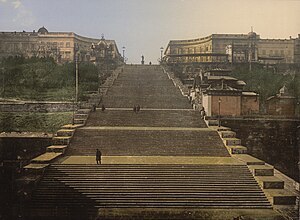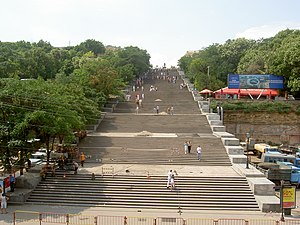User:DDima/sb2/Potemkin Stairs

The Potemkin Stairs (Ukrainian: Потьомкінські східц, Potemkinsky Skhidtsi; Originally: Primorsky Stairs; a.k.a: Richelieu Stairs) are 142-metre-long stairs constructed during 1837–1841, which descend from Primorsky Boulevard to the Odessa port in Odessa, Ukraine. The stairs are considered a formal entrance into the city from the direction of the sea and are commonly recognized as the symbol of Odessa.
History
[edit]The stairs were designed by St. Petersburg architects Avraam Melnikov, and F.K. Boffo in 1825. They were constructed during 1837-1841 in the classical style, and were originally named the Primorsky Stairs. On the top of the stairs, a statue of Duc de Richelieu, who governed Odessa at the beginning of the 19th century being actually the city’s first mayor, is located there. The stairs were made famous to many people in the former Soviet Union by the 1925 film "Battleship Potemkin" directed by Sergei Eisenstein. This film glorified the June 14, 1905 mutiny of the battleship Potemkin.
After the Russian Revolution, the Primorsky Stairs where renamed Potemkin Stairs to honor the memory of the Battleship Potemkin. After the Ukrainian independence in 1991, the Potemkin Stairs name was returned to Primorsky Stairs. But most locals call still prefer to call it the Potemkin Stairs.
Near the stairs, a funicular was built in 1906 to transport people up instead of walking. After 50 years of operation, the funicular was outdated and was later replaced by an escalator in the 1960s. Also, the stairs have been recently complemented with ramp over bridges to extend as far as the Novy Pier, where a modern structure of the new seaport is located on a high platform.

Construction
[edit]The steps were originally made of grayish-green sandstone brought from the northeastern Italian town of Trieste, which at the time it was an Austrian town. During the years, the stairs unfortunately weathered, and in 1933 they were reconstructed with granite.
The total height of the stairs reaches 30 meters, it is 140 meters long, and has ten flights of stairs. There are a total number of 192 steps which was originally 200, but eight of the lowest steps were buried when the foundation of the port was extended.
An interesting fact is that if looking down the stairs from the top, a person can only see the landings. On either side are parapets which seem parallel. This was created by gradually widening the stairways downwards. On the other hand, if looking up from the base of the stairs, a person can only see the stairs, and cannot see the 10 landings. It design creates somewhat of an optical illusion making the steps seem bigger than their actual size as upper flights are 13.4 meters (44.22 feet) wide while the lower flights are 21.6 meters (71.28 feet) wide bordered on each side by 2 meters (6.6 foot) wide steps and seven landings connecting the 192 steps.
External link
[edit]- (in English) "2odessa.com" (HTML). Retrieved May 20, 2006. Information and pictures on the Potemkin Stairs
